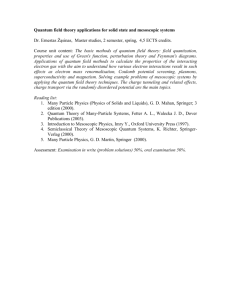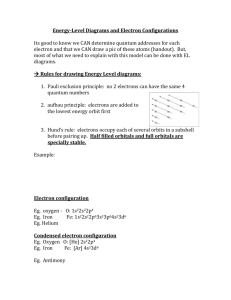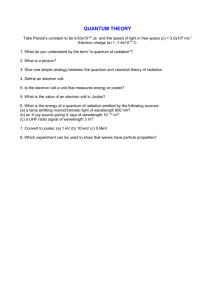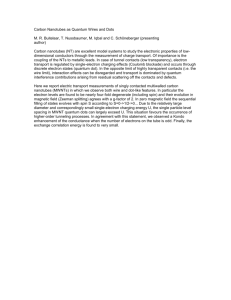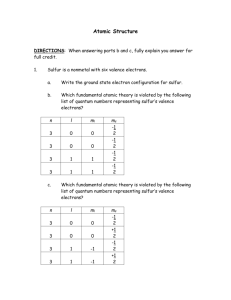The Electronic The Electronic T i T i Transport in Mesoscopic
advertisement
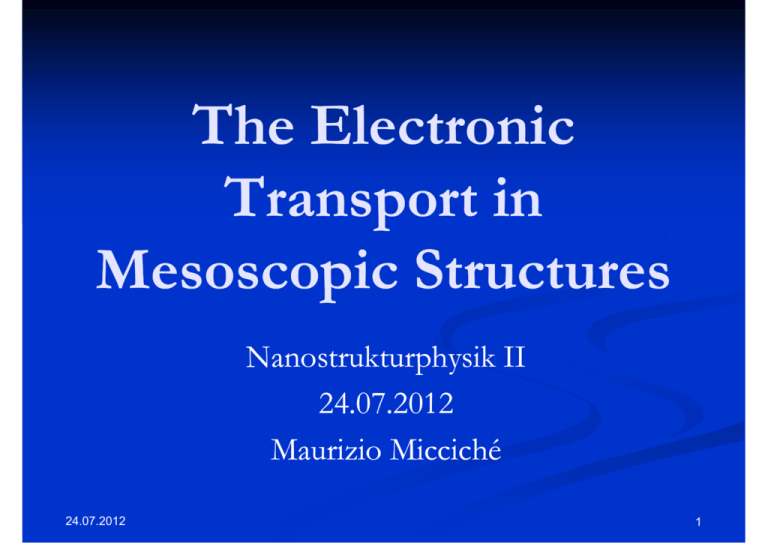
The Electronic T Transport in i Mesoscopic p Structures Nanostrukturphysik II 24.07.2012 Maurizio Micciché 24.07.2012 1 A Agenda d Introduction Electron--Electron Interaction and Quantum Electron Dots Electron--Box Electron Two Terminal Setup Single Electron Transistor (SET) 24.07.2012 2 I t d ti Introduction [1] microscopic [2] mesoscopic macroscopic l 24.07.2012 3 Introduction: I t d ti Classical Cl i l T Transport p t Classical electronic transport characterized by C d i i G Conductivity I A G= U =σ L Not applicable pp if: l < λF quantum nature dominates l < lmfp transport becomes b b ballistic lli i 24.07.2012 l < LΦ qquantum mechanical interference 4 Introduction: The Landauer Approach Describes conductance of mesoscopic systems Connectedd with h macrosc. reservoirs (only l µ and d T ddep.) Connection: ideal leads e.g. g quantum q wires Electrons are plane waves; no scattering Conductivity described by scattering matrix [4] 24.07.2012 5 Electron--Electron Interaction and Electron Quantum Dots Electrons in Spherical Capacitor repel each other but can always be further charged In small dimensions Electron interaction becomes more important Charge Energy must be greater than CB 1 E~ R C l bb Coulomb barrier i (CB) E(10nm) = 140 keV/cm k V/ [4] 24.07.2012 [4] 6 El t -Box ElectronElectron B Most simple oneone-Electron device Gate G Voltage V l controls l the h iislands l d electrostatic l i E Energy [[4]] 24.07.2012 7 El t -Box ElectronElectron B Electrons tunnel to island i l nd Island charges rises by e Temperature gives additional energy => less sharp coulomb steps [4] 24.07.2012 8 T Terminal Two T i l Setup S t Island connected with two tunnel barriers Symmetrical design (back and forth possible) e[4] 24.07.2012 9 T Terminal Two T i l Setup S t [4] 24.07.2012 10 T Terminal Two T i l Setup S t p UDS=0 no tunneling towards island Obvious?! No! UDS↑ => ΔES→I ↓ => one e- tunnels to island => Ec ↑ Tunneling from island to Drain ⇒ Lowering ΔES→I ⇒ Constant current by single electrons Current dependent on energy of the electrons l andd the h [5] charge energy Ec, which depend on… 24.07.2012 e[4] 11 T Terminal Two T i l Setup S t p Energy of the electron: UDS and kBT We want: energy mainly l dependent d d on UDS Charge g Energy gy Ec: size and charge g of island We want: Ec>> kBT Ec↑ => Risland↓ kBT↓ => T ↓ 24.07.2012 Risland T 1 µm 4K 1 nm 300 K 12 Th Si The Single l El Electron t T Transistor i t Combination of Electron Box and TTS Current controlled by UGS and UDS [4] 24.07.2012 [6] 13 Coulomb Barrier Oscillations [4] 24.07.2012 14 Th Si The Single l El Electron t T Transistor i t [4] 24.07.2012 15 SET Wh SET: Why?? Conductance of SET changes strongly (several orders off magnitude) m nit d ) due d to t UGS => Amplification of quantum signal (e.g. quantum computer) Conductance exhibits oscillations as a function of UGS SET is also a tunable tunnel junction Count e- with SET or create well defined currents I=nef (n: number of electrons transferred per cycle; f: f of ac control voltage) With small quantum dot ((~5nm) 5nm) single electron tunneling can be observed at room temperature 24.07.2012 16 SET: SET Wh Whatt ffor?? Problems with MOSFET (in ~20 years): Moore’s law (size ~ 20 nm) High integration density => > too much heat Quantum effects dominate, no classical description SET: Single electrons => low heat Atomic dimensions => high integration density Tunneling is fast => high switching frequencies 24.07.2012 17 SET F SET: Future t [7] 24.07.2012 18 Thank you for your attention tt ti 24.07.2012 19 Sources Sources 1: Wikipedia: Tunneleffekt 2: fitamball.de fitamball de 3: Wikipedia: Kugelkondensator 4: Der Einzelelektronentransistor; Andreas Klöber 5: archiexpo.de 6: Wikipedia: MOSFETMOSFET-Transistor 7: ucm.es/Quantum ucm.es/Quantum_comuter comuter 24.07.2012 20

